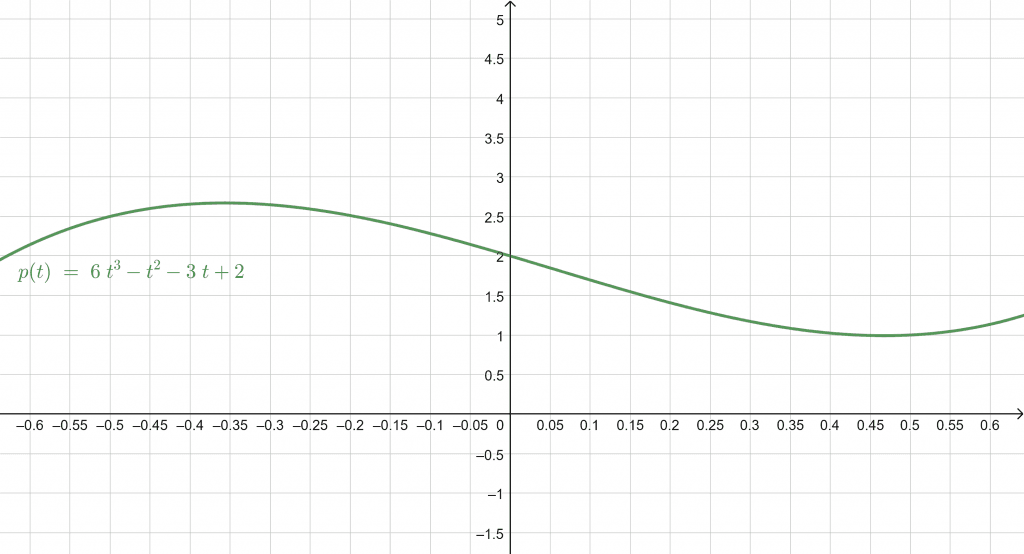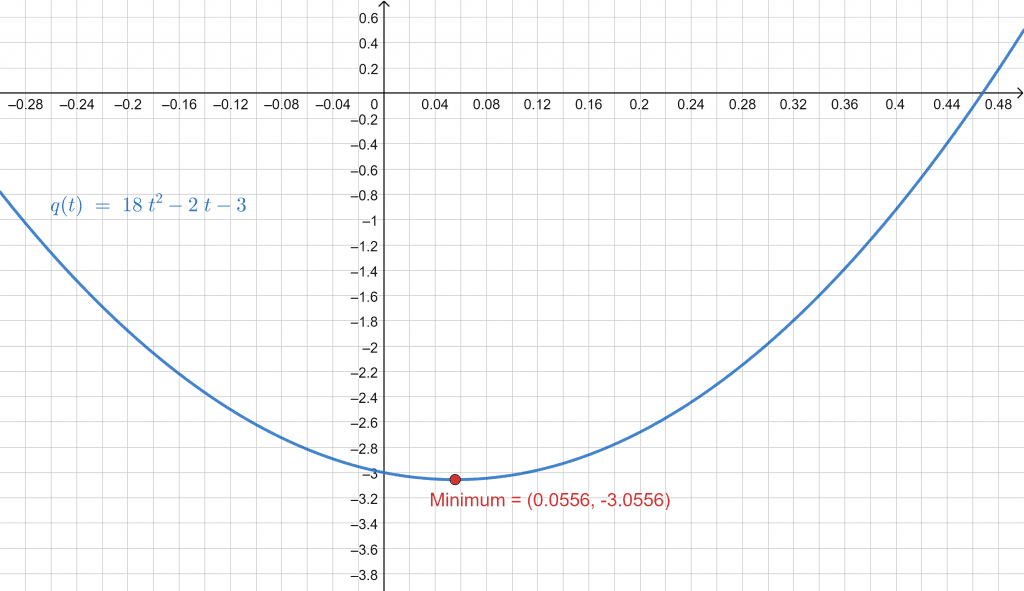JUMP TO TOPIC
Instantaneous Velocity Calculator + Online Solver With Free Steps
The Instantaneous Velocity Calculator finds an expression for the instantaneous velocity of an object as a function of time t by differentiating its given position, also as a function of time t.
Multivariate position functions of the type p(t, x1, x2, … , x_n) are not supported, so ensure that your position function is only dependent on time t and no other variables are involved.

What Is the Instantaneous Velocity Calculator?
The Instantaneous Velocity Calculator is an online tool that, given the position $\mathbf{p(t)}$ as a function of time $\mathbf{t}$, calculates the expression for instantaneous velocity $\mathbf{v(t)}$ by differentiating the position function with respect to time.
The calculator interface consists of a single text box labeled “Enter the Function x(t)” in which you enter the position function p(t).
Further, you have the “Calculate Instantaneous Velocity” button that, when pressed, will have the calculator evaluate the result by solving:
\[ v(t) = p’(t) = \frac{d}{dt} \, p(t) \]
On the contrary, if you have a position function and need to find the expression for instantaneous acceleration instead of velocity, you can use the calculator to do so. Knowing that:
\[ a(t) = v’(t) = \frac{d}{dt} \, v(t) \]
\[ a(t) = \frac{d}{dt} \, p’(t) \tag*{substituting $v(t) = p’(t)$} \]
a(t) = p’’(t)
We can see that finding a(t) requires running the calculator two times:
- Enter the position function p(t) and run the calculator. Note down the output expression for instantaneous velocity v(t) = p’(t).
- Enter v(t) and run the calculator again. The calculator now differentiates velocity with respect to time, and a(t) = v’(t) by definition.
Note that this is not the intended use of the calculator, but it works regardless.
How To Use the Instantaneous Velocity Calculator?
You can use the Instantaneous Velocity Calculator by entering the position function into the text box and pressing the “Calculate Instantaneous Velocity” button. As a mock example, let us suppose we have the position function of a ball:
\[ p(t) = t^3 + 5t^2 + 7 \]
And we want to find the expression for instantaneous velocity so we can calculate it at any given time t. We can do so by following the steps below.
Step 1
Ensure the position is given as a function of time t and no other variables are involved.
Step 2
Enter the position function into the text box. For our example, we type “t^3+5t^2+7” without commas.
Step 3
Press the Calculate Instantaneous Velocity button to get the resultant expression for instantaneous velocity as a function of time t.
Results
For our example, the result is:
\[ \frac{d}{dt} \left( t^3+5t^2+7 \right) = t(3t + 10) \]
Different Differentiation Methods
As in our mock example, it might be possible to arrive at the result with different approaches to evaluating the derivative. That is, we could find v(t) = p’(t) using the definition of a derivative, or we could use the power rule.
In the result sections of such cases, the calculator also shows a dropdown selection menu in the results section. There, you can choose the exact method to use for evaluating the result.
Using the Result
The calculator only provides the expression for instantaneous velocity v(t). In order to get values from this function, you need to evaluate it at:
\[ v(t=a) = a(3a + 10) \, \, \text{where} \, \, a \in \mathbb{R} \]
In our mock example, say you need the position and velocity of the ball at t = 10 time units. The instantaneous position is calculated as:
\[ p(t=10) = \left. t^3+5t^2+7 \right \rvert_{t \, = \, 10} \]
\[ \Rightarrow 10^3 + 5(10)^2 + 7 = 1000 + 500 +7 = 1507 \, \, \text{position units} \]
And the velocity as:
\[ v(t=10) = \left. t(3t + 10) \right \rvert_{t \, = \, 10} \]
\[ \Rightarrow 10 \left\{ 3(10) + 10 \right\} = 400 \, \, \text{velocity units} \]
Where the units are defined as:
\[ \text{velocity units} = \frac{ \text{position units} }{ \text{time units} } \]
How Does the Instantaneous Velocity Calculator Work?
The Instantaneous Velocity Calculator works by differentiating the position function p(t) with respect to time t to get the expression for instantaneous velocity v(t).
\[ v(t) = p’(t) = \frac{d}{dt} \, p(t) \]
Instantaneous Position
Also known as the position function denoted by p(t) here, the instantaneous position provides the exact position of an object at any time instant t. If the velocity function v(t) is known, the position function is the antiderivative of v(t):
\[ p(t) = \int_{t_i}^{t_f} v(t) \, dt\]
If the acceleration function a(t) is known:
\[ p(t) = \iint_{t_i}^{t_f} a(t) \, dt \cdot dt \]
This is useful for modeling complex object movements over time by incorporating higher order terms of time t. Figure 1 under Example 2 provides a graph of such a higher order position function.
Instantaneous Velocity
Denoted by v(t), instantaneous velocity refers to the exact velocity of an object at a given time instant t, at the position described by p(t).
If the position function is known, its derivative gets us the expression for instantaneous velocity. If the acceleration function a(t) is known instead, we get it as:
\[ v(t) = \int_{t_i}^{t_f} a(t) \cdot dt \]
We can use it to find the average velocity over an interval of time on the velocity curve. We may also find the maximum or minimum velocity using this expression and setting:
\[ \frac{d}{dt} \, v(t) = v’(t) =0 \tag*{(first derivative)} \]
And solving for the values of $\mathbf{t_m} = (t_1, \, t_2, \, \ldots, \, t_n)$ where $n$ is the degree of the polynomial $v’(t)$. Then set:
\[ \frac{d}{dt} \, v’(t) = v’’(t) = 0 \tag*{(second derivative)} \]
If the sign of the second derivative evaluated at time $t_i$ (from set of possible minima/maxima $\mathbf{t_m}$) is negative, the velocity at that time instant v(t=ti) is the maximum velocity vmax. If the sign is positive instead, v(t=t_i) is the minimum velocity vmin.
Instantaneous Acceleration
The derivative of v(t) or double derivative of p(t) with respect to time gets us the instantaneous acceleration a(t). The same applications mentioned for instantaneous velocity carry over to instantaneous acceleration.
Solved Examples
Example 1
Consider the position function $p(t) = 2t^2 + 8(t-1) +5$. Find the expression for instantaneous velocity v(t).
Solution
Using the definition of derivative:
\[ f’(x) = \frac{d}{dx} \, f(x) = \lim_{h \, \to \, 0} \left\{ \frac{f(x+h)-f(x)}{h} \right\} \]
Applying our notation:
\[ p’(t) = \lim_{h \, \to \, 0} \left\{ \frac{p(t+h)-p(t)}{h} \right\} \]
Solving the numerator of the limit:
\[ p(t+h)-p(t) = \left[ 2(t+h)^2 + 8(t+h-1) + 5 \right] – \left[ 2t^2 + 8t – 8 + 5 \right] \]
\[ p(t+h)-p(t) = 2(t^2+2th+h^2)+8t+8h-8+5-2t^2-8t+3 \]
Rearranging common variables next to each other and solving:
\[ p(t+h)-p(t) = 2t^2-2t^2+8t-8t+2h^2+8h+4th-8+5+3 \]
\[ p(t+h)-p(t) = 2h^2+8h+4th \]
Putting this value into the equation for $p’(t)$:
\[ p’(t) = \lim_{h \, \to \, 0} \left( \frac{2h^2+8h+4th}{h} \right) \]
\[ p’(t) = \lim_{h \, \to \, 0} \left( 2h+8+4t \right) \]
Putting in the limit h $\to$ 0:
\[ \Rightarrow p’(t) = 8 + 4t = 4(t+2)\]
Which is the result of the calculator for “ 2t^2+8(t-1)+5” as input.
Example 2
For the position function and its plot (Figure 1):
\[ p(t) = 6t^3-t^2-3t+2 \]

Figure 1
Find the maximum and minimum velocities.
Solution
The derivative is given as:
\[ p’(t) = \frac{d}{dt} \left( 6t^3-t^2-3t+2 \right) \]
Applying the derivative to each term separately:
\[ p’(t) = \frac{d}{dt} \, 6t^3 + \frac{d}{dt} \, -\left( t \right)^2 + \frac{d}{dt} \, -3t + \frac{d}{dt} \, 2 \]
Taking out the constants and setting derivative of purely constant terms to 0:
\[ p’(t) = 6 \frac{d}{dt} \, t^3-\frac{d}{dt} \, t^2-3 \frac{d}{dt} \, t \]
Using the power rule and the fact that $\textstyle \frac{d}{dx} \left( \pm \, x \right) = \pm \, 1$, we get:
\[ p’(t) = 6 \left[ 3 \cdot t^{3-1} \cdot \frac{d}{dt} \, t \right]-\left[ 2 \cdot t^{2-1} \cdot \frac{d}{dt} \, t \right]-\bigg[ 3 \cdot 1 \bigg] \]
\[ p’(t) = 6 \left[ 3t^2 \cdot 1 \right]-\left[ 2t \cdot 1 \right]-3 \]
\[ \Rightarrow p’(t) = v(t) = 18t^2-2t-3 \]
The above is the calculator’s result for “6t^3-t^2-3t+2” as input.
Finding Extrema
Differentiating v(t)$with respect to time t:
v’(t) = 36t-2
Setting it to 0:
36t-2 = 0
\[ \Rightarrow t = \frac{1}{18} \approx 0.05556 \]
Differentiating v’(t) again and evaluating the result at $t = \frac{1}{18}$:
v’’(t) = 36
\[ \Rightarrow v’’ \left( t = \frac{1}{18} \right) = 36 \]
Since v’’(t) > 0, $t = \frac{1}{18}$ corresponds to a minimum on the velocity curve v(t):
\[ v \left( t = \frac{1}{18} \right) = v_{min} = 18 \left( \frac{1}{18} \right)^2-2 \left( \frac{1}{18} \right)-3 \]
\[ \Rightarrow v_{min} = \frac{-55}{18} \approx -3.05556 \]
As there is only one root for v’(t) = 0, the other extremum must be unbounded. That is, $v_{max} \to \infty$. The plot in Figure 2 verifies these findings:

Figure 2
All images/graphs were created using GeoGebra.
